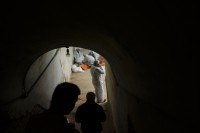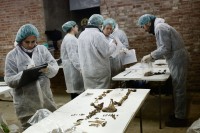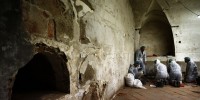Last April, the Convent of the Barefoot Trinitarians in Madrid, burial place of Miguel de Cervantes, author of The Adventures of the Ingenious Nobleman Don Quixote of La Mancha, one the most important books in the Western literary canon, was scanned with ground-penetrating radar in the first phase of a search for the iconic writer’s body. Cervantes was buried in the convent in 1616, and while the location of the grave was known at the time, when the convent was enlarged in 1673 the burials were left unmarked. Hoping to be able to provide a memorial marker worthy of Spain’s greatest writer and a locus for literary pilgrims to pay their respects, historian Fernando de Prado raised funds from the city of Madrid and private donors to sweep the convent for possible burial sites.
 The initial GPR sweeps detected anomalies consistent with graves in three spots in the crypt under the transept of the convent church. Historical records indicate there were at least two other people buried in the same area where Cervantes was interred, making the discovery of three graves particularly noteworthy. In a poetic twist, the space had been rented to a publishing company for years, so before the team could examine it they had to remove piles of old books and floor-to-ceiling bookshelves.
The initial GPR sweeps detected anomalies consistent with graves in three spots in the crypt under the transept of the convent church. Historical records indicate there were at least two other people buried in the same area where Cervantes was interred, making the discovery of three graves particularly noteworthy. In a poetic twist, the space had been rented to a publishing company for years, so before the team could examine it they had to remove piles of old books and floor-to-ceiling bookshelves.
Now a team of archaeologists and forensic anthropologists has broken ground in the crypt. The small crypt has been turned into a lab for the time being, with up to 20 experts working in it at the same time (there are 30 people in the team). They will examine the human skeletal remains for evidence that points to Cervantes.
Because Cervantes has no living descendants, even if DNA is recoverable from the skeletal remains, comparisons will be tricky if not impossible. His sister Luisa de Cervantes was buried in a marked grave in a convent 20 miles out of Madrid so there’s a chance her remains might provide a means for comparative DNA analysis, but there’s no guarantee the convent will allow her bones to be exhumed and even if it does, there’s no guarantee a testable sample of 400-year-old DNA can be extracted.
 Researchers will most likely have to rely on physical evidence like the marks of wounds he received while fighting aboard the galley Marquesa during the Battle of Lepanto on October 7th, 1571. He was shot twice in the chest and once in the left arm. The bullet to his arm broke both radius and ulna and severed a nerve. He was a young man of 24 when he was wounded; he never used his left hand again. Should they find a left arm bearing signs of having been shot, broken and atrophied from 45 years of disuse, this will be strong evidence that they’ve found the remains of the author.
Researchers will most likely have to rely on physical evidence like the marks of wounds he received while fighting aboard the galley Marquesa during the Battle of Lepanto on October 7th, 1571. He was shot twice in the chest and once in the left arm. The bullet to his arm broke both radius and ulna and severed a nerve. He was a young man of 24 when he was wounded; he never used his left hand again. Should they find a left arm bearing signs of having been shot, broken and atrophied from 45 years of disuse, this will be strong evidence that they’ve found the remains of the author.
Cervantes asked to be buried in the Convent of the Barefoot Trinitarians because he had a profound connection to them. The convent’s order, the Order of the Most Holy Trinity for the Redemption of the Captives, was founded in the 12th century to help ransom Christians taken captive during the crusades or by non-Christian pirates. When Cervantes and his younger brother were captured by Algerian pirates in 1575, the Order of the Most Holy Trinity helped his family raise the ransom to free them after five years of slavery in Algiers.
 Since the convent was a small, poor one, few people chose to be buried there. Cervantes’ debt of gratitude to the order inspired his choice. Given the small number of burials, what are the odds there will be the remains of a completely different person, also an adult male of around 70 years old at time of death, with the same injuries? Last year the figures bandied about were a dozen to 15 people buried in the convent, but the crypt has about 36 burial niches in the wall. That corresponds to the number of chaplains the convent has had over the centuries before the niches in the north wall were plastered over. The thin layer of plaster, already peeling, will be removed. Any writing on the niche doors identifying who was buried there will be documented and endoscopic cameras will be threaded through holes to examine the remains.
Since the convent was a small, poor one, few people chose to be buried there. Cervantes’ debt of gratitude to the order inspired his choice. Given the small number of burials, what are the odds there will be the remains of a completely different person, also an adult male of around 70 years old at time of death, with the same injuries? Last year the figures bandied about were a dozen to 15 people buried in the convent, but the crypt has about 36 burial niches in the wall. That corresponds to the number of chaplains the convent has had over the centuries before the niches in the north wall were plastered over. The thin layer of plaster, already peeling, will be removed. Any writing on the niche doors identifying who was buried there will be documented and endoscopic cameras will be threaded through holes to examine the remains.
The real hope is in the three grave sites under the terracotta tile floor, but if they prove fruitless, there are four other possible locations about two meters under the floor of the church that the GPR sweep indicated as possible grave sites.